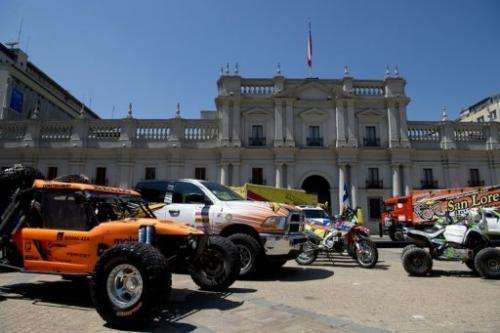Dakar Rally rapped over 20 million year fossil damage

Palaeontologists have warned that the Dakar Rally, which will thunder through Peru and Chile next month, poses a serious risk to whale and dolphin fossils dating back more than 20 million years.
Scientists issued their warning to highlight claims that the 2012 edition of the gruelling 8,400 kilometre endurance event had caused irreparable damage to ancient Miocene era sites in the Ica region of southern Peru.
"The damage is evident in the area of Ica, where you can see the deterioration of many fossils because the vehicles drove over them," Vildoso Carlos, director of the Peruvian Institute of Palaeontology, told AFP.
"We have many skeletons of large mammals, especially whales and dolphins, and the fossilized remains of invertebrates that have suffered damage due to passing vehicles. The course passed virtually over the animals."
The director of Lima's Meyer Honninger palaeontology museum, Klaus Honninger, said he had informed the Dakar organisers of the damage, but claimed his complaints had been met with little interest.
He also said that some drivers steer away from the official track in order to take a simpler route.
The problem is compounded by hundreds of spectators who show little respect for the area's history.
"They leave the desert in a terrible state," added Honninger.
"I have seen people smash fossilised whale vertebrae and throw tons of garbage around. I have even found old tyres left behind by the competitors."
Neither the race organisers nor the minister of culture, who are responsible for Peru's heritage, are "accepting responsibility" for this destruction, he added.
"Our position is that the organisers should find another route to avoid further deterioration of this fossil graveyard," said Honninger.
The Ocucaje desert has yielded fossils of giant sharks and whales measuring up to 20 metres long and it was in the same area that Peruvian geologists discovered last February the remains of a whale believed to be 3.6 million years old.
Peru's culture minister, Luis Peirano, who attended the official presentation of the 2013 Dakar Rally on Tuesday, said that the race will not compromise the country's heritage.
"Peru has a rich heritage that must be protected," he said, adding that officials in every region will work with organisers to avoid any further damage.
In neighbouring Chile, where the January 5-20 event will end, the authorities have worked with organisers to mark tracks, especially in the north where vehicles could damage ancient cities such as San Pedro de Atacama.
"In collaboration with the organisation of the rally we have developed a route that avoids the areas identified as being at risk from the point of view of the environment and archeology," deputy secretary for sports, Gabriel Ruiz Tagle, told AFP.
The 2013 Dakar Rally will feature 459 vehicles—cars, bikes, trucks and quads—and will cover 8,400km of Peru and Chile, with a stay in Argentina.
(c) 2012 AFP


















